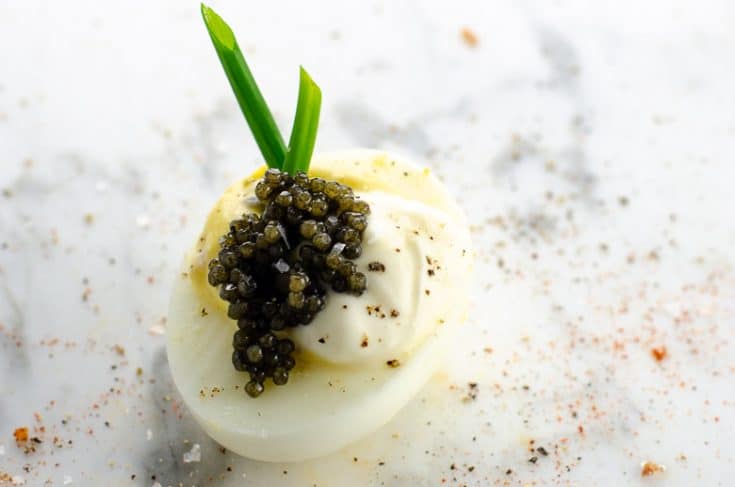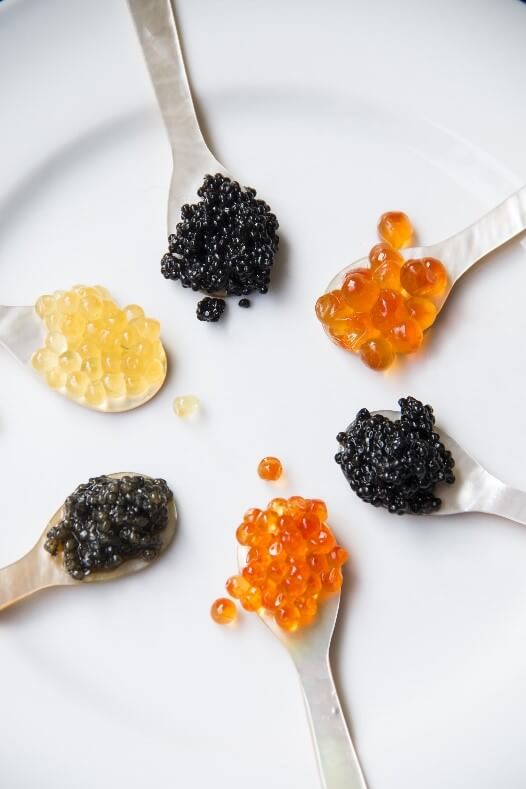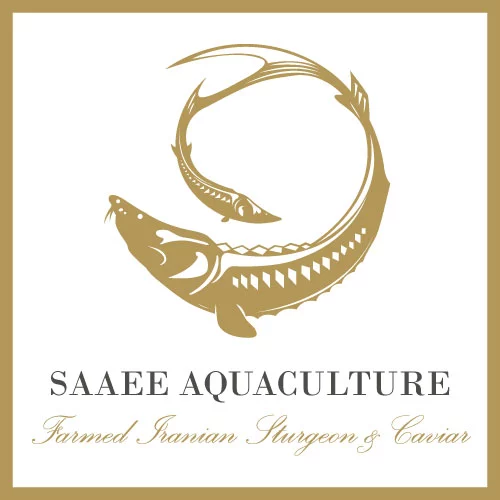
Caviar comes from sturgeon fish. When the ovaries of a sturgeon fish, is harvested and properly salted, they end up becoming black gold! Mind you Caviar (also known as Persian: , romanized: khâvyâr,Egg -bearing') is a food consisting of salt-cured roe of just the family Acipenseridae. The first known record of caviar dates back to the Greek scholar Aristotle. In the 4th Century B.C. Aristotle described this delicacy as the eggs of the sturgeon, heralded into banquets amongst trumpets and flowers.
Roe is the fully ripe, unfertilized internal egg masses in the ovaries, or the released external egg masses of fish and certain marine animals. When we say "roe", we are referring to all unfertilized eggs collected from marine animals.
Roe that comes from a fish other than the sturgeon is not true caviar, and it is classifiable as a caviar substitute. For example, the eggs of lumpfish, whitefish and salmon may be prepared or preserved as caviar substitutes. Caviar is a delicacy consisting of low salt-cured, unfertilized fish roe of the Acipenseridae family, better known as the sturgeon fish. Basically, both caviar and roe are fish eggs, but caviar is a particular kind of roe from the sturgeon family that has been cured. Uncured roe is commonly called “green eggs in the business.
According to the US data (USDA, 2016), there are fundamental differences between the eggs and caviar. Compared to other eggs, caviar is characterized by a much high energy value, and contains twice as much fat, more than twelve times as much sodium, magnesium and iron, and also ten times more calcium. Caviar is classified as a dainty food product with high nutritional and flavor value.
Polyunsaturated fatty acids, especially the omega-3 (EPA and DHA), which are not produced in the human body, play an important role in prevention of cardio-vascular, neurodegenerative (Alzheimer’s disease) and other diseases (Calder, 2018; Dutkowska and Rachoń, 2015; Siscovick et al., 2017).
Linoleic acid (C18: 2, n-6 LA) inhibits the formation and development of breast, skin, colorectum, and primary liver cancers (Chin et al., 1992; Stanley and Hunter, 2001). Conjugated linoleic acids have been found to have antimutagenic activity, to lower blood cholesterol (especially that of LDL).
Docosahexaenoic acid (C22:6, DHA) is an important component of the phospholipids of cell membranes and takes part in the regulation of their permeability. It occurs in the cell membranes of the whole organism, including the retinal cell membranes and the neurons of the cerebral cortex, where it constitutes half of all fatty acids. The DHA deficit in nerve cells is associated with disorders of the nervous system, increased sensitivity to stress, hyperactivity, aggression, and dyslexia and schizophrenia (Logan, 2004). In turn, eicosanoids formed from n-3 acids (e.g. ei-cosapentaenoic acid, EPA) have anti-inflammatory and anticoagulant properties, and suppress excessive vasoconstriction and cancer development.
Edible fish roe:
The most famous fish roe is, of course, sturgeon. However, there are many other roes!
Sturgeon-style Roes:
Though not actually from sturgeon, these fish roes are similar enough that they can be used in place of sturgeon roe for canapés, salads & garnishes.
Paddlefish Roe
Wild American Paddlefish Roe is a very affordable substitute for sturgeon caviar.
Bowfin Roe
wild American Bowfin roe has a mild tangy flavor and small brown-black grains.
Whitefish Roe
The small golden eggs of this roeare harvested from Golden Whitefish, a species native to the Great Lakes. Its flavor is tangy yet slightly sweet.
Trout Roe
Harvested from freshwater trout caught in inland lakes, this medium-sized roes has a firm texture, strong flavor, and a translucent pink appearance with tiny orange spots.
Sushi-style Roes:
Most commonly found in sushi, these colorful roes can also be used in salads, noodle dishes, canapés, eggs or as an eye-catching garnish. They are most commonly known by their Japanese names.
Ikura
The largest of the sushi-style roes, this ikura has been sustainably harvested from plentiful pink salmon caught by family-run fishing boats.
Tobiko
Tobiko eggs are much smaller than Ikura. They are available in a variety of flavors.
Masago
The smallest of the sushi-style roes, orange colored masago offering a different appearance and slightly different texture.
Uni
Unlike the other roes that offer perfectly round jewel-like eggs, fresh sea urchin roe is more paste-like in consistency.
Specialty Roes:
Black Lumpfish Roe
A Scandinavian delicacy, lumpfish roe is crunchy with a pronounced salty-fish flavor. This caviar is pasteurized, making it shelf stable.
Tuna Bottarga
Tuna roe that has been pressed, dried, and salt cured, bottarga is a beloved Mediterranean ingredient.

Caviar Types
Beluga Huso huso.
These large sturgeons are now extremely rare. Beluga eggs are the largest and are light grey to nearly black with a fine skin that melts in the mouth. The flavor is delicately fishy.
Oscietre Acipenser gueldenstaedti.
These sturgeons produce the widest range of eggs. The eggs fade from dark golden to a pale amber as the fishes age and tend to have a subtle "walnuts and cream" flavor.
Sevruga Acipenser stellatus
These are the smallest sturgeon whose grey-black eggs are fine grained. They taste distinctively salty. Sevruga is the least expensive, yet highly prized for the unique flavor.
Sterlet Acipenser ruthenus
The Sterlet is similar to, but smaller than, the average Sevruga is known to reach 1.25 m (4 ft) and weigh of 26 kg (55 lb). Sibrian Asipenser Baerii. It has medium sized sublimely re-fined pearls and is blackish or charcoal in colour.
Kaluga Huso dauricus
One of the largest sturgeon species comes from the Amur and Liman Rivers in China.
Schipp Acipenser nudiventris.
Schipp is the result of cross-breeding a Sevruga with a Sterlet

